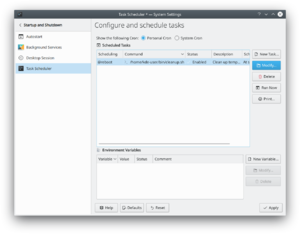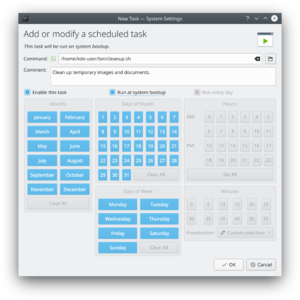System Settings/Task Scheduler/it: Difference between revisions
Updating to match new version of source page |
Created page with "Se a volte un operazione, o più operazioni, hanno bisogno di un'impostazione di una variabile, questa deve essere aggiunta nella sezione '''Environment Variables'''. Il programma '''cron''' utilizza il proprio ambiente, non delle variabili di sistema o specifiche per l'utente. Fai clic su '''Nuova variabile''' per aggiungere una nuova definizione di variabile, oppure su '''Modifica''' per modificarne una esistente." |
||
| (30 intermediate revisions by 2 users not shown) | |||
| Line 1: | Line 1: | ||
<languages /> | <languages /> | ||
=== Informazioni generali == | <span id="General_Information"></span> | ||
== Informazioni generali == | |||
Il Pianificatore di operazioni è un'interfaccia grafica al classico programma "cron". Con esso i comandi (o "operazioni") possono essere eseguiti ad orari specifici, in certi giorni o in certe date, oppure a intervalli specifici (tempo tra le esecuzioni). | |||
[[Image:Kcron-screenshot-de.png|thumb|300px|center|Il Pianificatore di operazioni in Plasma 5]] | |||
<span id="Usage"></span> | |||
=== Utilizzo === | === Utilizzo === | ||
In KDE 4.4 '''KCron''' è un modulo accessibile in <menuchoice>Impostazioni di sistema -> Avanzate -> sezione Sistema -> Pianificatore di operazioni</menuchoice>. Se non è presente controlla di aver installato il pacchetto '''kdeadmin'''. In KDE 4.5 lo troverai in <menuchoice>Impostazioni di sistema -> sezione Amministrazione del sistema -> Pianificatore di operazioni</menuchoice>. Alcune distro creano un pacchetto separato per '''KCron''', dunque se non lo vedi dovresti cercare questo termine nel tuo repository. | |||
<span id="Adding_and_Modifying_tasks"></span> | |||
=== Aggiunta e modifica delle operazioni === | |||
Fai clic su <menuchoice>Nuova operazione...</menuchoice> per aggiungerne una nuova, oppure "Modifica" per modificarne una esistente: verrà visualizzata la pagina '''Aggiungi o modifica operazione esistente'''. | |||
[[Image:kcron-task-dialog.png|thumb|300px|center|La pagina "Aggiungi o modifica operazione esistente" delle Impostazioni di sistema]] | |||
* Inserisci il comando da eseguire. Fai clic sull'icona a cartella per sceglierla dalla finestra. | |||
* Inserisci un comando (facoltativo). Dovrebbe essere descrittivo, in modo da spiegare cosa fa l'operazione: non sempre è ovvio. | |||
* Fai clic su '''Abilita questa operazione''' per abilitarne l'esecuzione. | |||
* Fai clic su '''Esegui all'avvio del sistema''' per abilitare l'esecuzione dello script ad ogni avvio del sistema. | |||
* Fai clic su '''Esegui ogni giorno''' per abilitare l'esecuzione dello script ogni giorno. Questo selezionerà automaticamente le opzioni appropriate. | |||
* Usando i pulsanti scegli quale comando dovrebbe essere eseguito. Non sono richiesti tutti i parametri: quelli non necessari possono essere lasciati vuoti. | |||
** Le ore e i minuti sono l'ora del giorno quando eseguire l'operazione, non un intervallo. | |||
* Quando hai finito fai clic su <menuchoice>OK</menuchoice>. L'operazione verrà aggiunta e programmata, se abilitata. | |||
{{Tip|Fai clic su <menuchoice>Esegui adesso</menuchoice> per eseguire l'operazione immediatamente dopo la sua aggiunta o la sua modifica.}} | |||
<span id="Removing_a_task"></span> | |||
=== Rimozione di un operazione === | |||
Per rimuovere completamente un operazione, selezionala dall'elenco e fai clic sul pulsante '''Elimina'''. Questo rimuoverà in modo permanente l'operazione. | |||
<span id="Environment_Variables"></span> | |||
== Variabili d'ambiente == | |||
Se a volte un operazione, o più operazioni, hanno bisogno di un'impostazione di una variabile, questa deve essere aggiunta nella sezione '''Environment Variables'''. Il programma '''cron''' utilizza il proprio ambiente, non delle variabili di sistema o specifiche per l'utente. Fai clic su '''Nuova variabile''' per aggiungere una nuova definizione di variabile, oppure su '''Modifica''' per modificarne una esistente. | |||
* Inserisci il nome della variabile da usare. Questo nome: | |||
* | ** Deve essere composto solo da lettere, numeri e underscore ('_') | ||
** Deve iniziare con una lettera | |||
* | ** Non dovrebbe essere una variabile di sistema riservata o usata comunemente. Per maggiori dettagli vedi https://pubs.opengroup.org/onlinepubs/000095399/basedefs/xbd_chap08.html | ||
* | |||
* | |||
* | |||
* | |||
* | |||
Il valore che la variabile conterrà. Può essere un numero o una stringa. | |||
* Inserisci una breve descrizione della variabile. | |||
<span id="Hints"></span> | |||
=== Suggerimenti === | === Suggerimenti === | ||
| Line 31: | Line 62: | ||
* Lo strumento a riga di comando che ti permette di vedere i cron-jobs attualmente definiti è {{Input|1=crontab -l}} (l'ultima è la lettera L). | * Lo strumento a riga di comando che ti permette di vedere i cron-jobs attualmente definiti è {{Input|1=crontab -l}} (l'ultima è la lettera L). | ||
<span id="More_Information"></span> | |||
== Maggiori informazioni == | |||
* [https://docs.kde.org/stable5/en/kdeadmin/kcontrol5/kcron/index.html Documentazione ufficiale di KDE] | |||
* [https://en.wikipedia.org/wiki/Cron Cron] (Wikipedia) | |||
* [https://wiki.archlinux.org/index.php/cron Cron] (wiki di Arch Linux) | |||
[[Category:Sistema/it]] | [[Category:Sistema/it]] | ||
Latest revision as of 22:46, 5 August 2024
Informazioni generali
Il Pianificatore di operazioni è un'interfaccia grafica al classico programma "cron". Con esso i comandi (o "operazioni") possono essere eseguiti ad orari specifici, in certi giorni o in certe date, oppure a intervalli specifici (tempo tra le esecuzioni).

Utilizzo
In KDE 4.4 KCron è un modulo accessibile in . Se non è presente controlla di aver installato il pacchetto kdeadmin. In KDE 4.5 lo troverai in . Alcune distro creano un pacchetto separato per KCron, dunque se non lo vedi dovresti cercare questo termine nel tuo repository.
Aggiunta e modifica delle operazioni
Fai clic su per aggiungerne una nuova, oppure "Modifica" per modificarne una esistente: verrà visualizzata la pagina Aggiungi o modifica operazione esistente.

- Inserisci il comando da eseguire. Fai clic sull'icona a cartella per sceglierla dalla finestra.
- Inserisci un comando (facoltativo). Dovrebbe essere descrittivo, in modo da spiegare cosa fa l'operazione: non sempre è ovvio.
- Fai clic su Abilita questa operazione per abilitarne l'esecuzione.
- Fai clic su Esegui all'avvio del sistema per abilitare l'esecuzione dello script ad ogni avvio del sistema.
- Fai clic su Esegui ogni giorno per abilitare l'esecuzione dello script ogni giorno. Questo selezionerà automaticamente le opzioni appropriate.
- Usando i pulsanti scegli quale comando dovrebbe essere eseguito. Non sono richiesti tutti i parametri: quelli non necessari possono essere lasciati vuoti.
- Le ore e i minuti sono l'ora del giorno quando eseguire l'operazione, non un intervallo.
- Quando hai finito fai clic su . L'operazione verrà aggiunta e programmata, se abilitata.
Rimozione di un operazione
Per rimuovere completamente un operazione, selezionala dall'elenco e fai clic sul pulsante Elimina. Questo rimuoverà in modo permanente l'operazione.
Variabili d'ambiente
Se a volte un operazione, o più operazioni, hanno bisogno di un'impostazione di una variabile, questa deve essere aggiunta nella sezione Environment Variables. Il programma cron utilizza il proprio ambiente, non delle variabili di sistema o specifiche per l'utente. Fai clic su Nuova variabile per aggiungere una nuova definizione di variabile, oppure su Modifica per modificarne una esistente.
- Inserisci il nome della variabile da usare. Questo nome:
- Deve essere composto solo da lettere, numeri e underscore ('_')
- Deve iniziare con una lettera
- Non dovrebbe essere una variabile di sistema riservata o usata comunemente. Per maggiori dettagli vedi https://pubs.opengroup.org/onlinepubs/000095399/basedefs/xbd_chap08.html
Il valore che la variabile conterrà. Può essere un numero o una stringa.
- Inserisci una breve descrizione della variabile.
Suggerimenti
- Tutti i file che vengono modificati si trovano nella cartella /etc/cron dove ci sono numerosi file da guardare.
- Lo strumento a riga di comando che ti permette di vedere i cron-jobs attualmente definiti è
crontab -l
(l'ultima è la lettera L).
Maggiori informazioni
- Documentazione ufficiale di KDE
- Cron (Wikipedia)
- Cron (wiki di Arch Linux)

